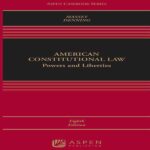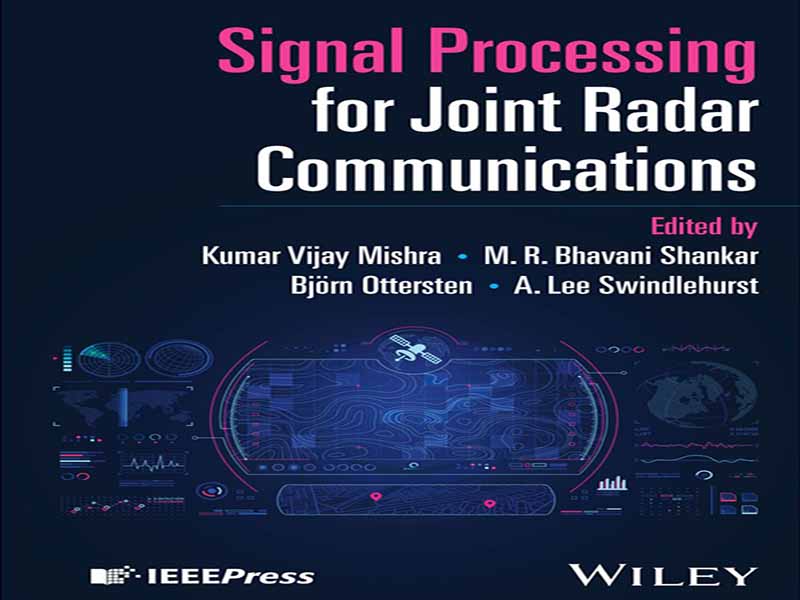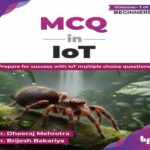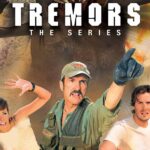- عنوان کتاب: Signal Processing for Joint Radar Communications
- نویسنده: Roberto Danovaro, Paul Snelgrove
- حوزه: پردازش سیگنال
- سال انتشار: 2024
- تعداد صفحه: 972
- زبان اصلی: انگلیسی
- نوع فایل: pdf
- حجم فایل: 23.8 مگابایت
ما مفتخریم که این کتاب جدید، پردازش سیگنال برای رادار و ارتباطات مشترک، منتشر شده توسط انتشارات معتبر Wiley-IEEE، را ویرایش میکنیم. این کتاب شامل ۱۴ فصل است که توسط متخصصان فوقالعاده ماهر از دانشگاهها و آزمایشگاههای تحقیقاتی در سراسر جهان نوشته شده است. تمرکز این کتاب بر جنبههای پردازش سیگنال رادار و ارتباطات مشترک (JRC) است – یکی از فعالترین مسائل مورد تحقیق در بیش از ۱۵ انجمن/جامعه IEEE. فصلها توسط ویراستارانی انتخاب شدهاند که مجموعاً ۱۲۰ سال تجربه در آزمایشگاههای تحقیقاتی معتبر دارند. آینده دسترسی به طیف فرکانسی به طور فزایندهای به اشتراک گذاشته شده، پویا و ایمن خواهد بود. اتحادیه بینالمللی مخابرات (ITU) حداقل از سال ۱۹۳۷ تخصیص باندهای رادیویی را آغاز کرد. استاندارد باند رادار IEEE 521، که از سال ۱۹۷۶ حفظ شده است، از شیوههای تعیین طیف که در طول جنگ جهانی دوم سرچشمه گرفته است، پیروی میکند. در طول چندین دههی متوالی گسترش پهنای باند برای حسگری، ناوبری، ارتباطات بیسیم، زمانبندی و موقعیتیابی، برنامهریزان سیاستگذاری و متخصصان فناوری با فشارهای ناشی از استفادهی ناکارآمد و بیش از حد محتاطانه از طیف فرکانسی مواجه بودهاند. قوانین مرسوم اشتراکگذاری طیف فرکانسی بیشتر برای بدترین سناریوها تدوین شدهاند تا برای استفادهی بهینه از فرکانسهای موجود. این رویکرد ناگزیر منجر به درگیری میشود زیرا طیف الکترومغناطیسی منبعی کمیاب است. در سال 2021، کمیسیون ارتباطات فدرال ایالات متحده (FCC) توسط AT&T به دلیل تخصیص 6 تا 7 گیگاهرتز توسط FCC برای تخصیص پویای کانالهای مجاز به نقاط دسترسی Wi‐Fi برای پروتکل Wi‐Fi 7 داخلی، مورد شکایت قرار گرفت. اداره هوانوردی فدرال ایالات متحده (FAA) اخیراً درگیر نبردی بسیار علنی با صنعت هواپیمایی بر سر استفاده از باند C برای خدمات بیسیم نسل پنجم (5G) در نزدیکی فرودگاهها شده است. در باندهای پایینتر، FCC برای بهروزرسانی مدلهای انتشار خود برای احکام باند تلویزیونی خود به چالش کشیده شده است تا امکان استفاده مجدد از باندهای تلویزیونی برای سایر خدمات فراهم شود. در نتیجه، سیستمهای حسگر (رادار، لیدار یا سونار) که طیف فرکانسی را با ارتباطات بیسیم (فرکانس رادیویی/ RF، نوری یا صوتی) به اشتراک میگذارند و همچنان بدون هیچ گونه افت عملکرد قابل توجهی عمل میکنند، توجه تحقیقاتی قابل توجهی را به خود جلب کردهاند. اگرچه بخش بزرگی از این باندها هنوز مورد استفاده قرار نگرفتهاند، رادارها برای حسگری و تشخیص هدف و همچنین افزایش طیف برای انجام مأموریتهایی مانند نظارت ثانویه، عملیات RF یکپارچه چند منظوره، رانندگی خودکار با قابلیت ارتباطات و قابلیتهای شناختی، نیاز به دسترسی مداوم به این باندها دارند. از سوی دیگر، تقاضای صنعت بیسیم برای طیف فرکانسی جهت ارائه خدمات جدید و تطبیق با تعداد زیادی از کاربران با نیاز به نرخ داده بالا همچنان رو به افزایش است. طیف فرکانسی فعلی به دلیل تخصیص بسیار پراکنده آن، بسیار ناکارآمد استفاده میشود. سیستمهای بیسیم نوظهور مانند فناوری ارتباطات تجاری تکامل بلندمدت (LTE)، نسل پنجم (5G)، وایفای، اینترنت اشیا (IoT) و خدمات رادیویی پهنباند شهروندان (CBRS) در حال حاضر باعث ایجاد تداخل طیفی در رادارهای نظامی، هواشناسی، نجوم و نظارت بر هواپیماها میشوند. به طور مشابه، سیگنالهای رادار در باندهای مجاور به طیف اختصاص داده شده برای ارتباطات نشت میکنند و کیفیت خدمات را کاهش میدهند. بنابراین، برای رادار و ارتباطات ضروری و مفید است که استراتژیهایی را برای عملکرد همزمان و فرصتطلبانه در باندهای طیفی مشابه به شیوهای سودمند برای هر دو طرف، توسعه دهند. تداخل ناشی از سایر ساطعکنندهها و کاهش آن برای دههها مورد توجه IEEE بوده است. تا اوایل دهه 1960، IEEE تراکنشهای IEEE در مورد تداخل فرکانس رادیویی را به رهبری گروه فنی حرفهای IRE در مورد تداخل فرکانس رادیویی منتشر میکرد. انتشار این مجله در سال ۱۹۶۳ متوقف شد. نشریه ادواری «مرزهای فناوری: روندهای تحقیقات الکترونیک» نوشته ماترا و مویر در جلد ۶۳ خود که در سال ۱۹۵۸ منتشر شد، بر تداخل رادار-ارتباطات تمرکز داشت. ادبیات علمی در مورد سیستمهای JRC تا دهه ۲۰۰۰ عمدتاً پراکنده باقی ماند. با این حال، همپوشانی طیفی رادارهای موج سانتیمتری با تعدادی از سیستمهای بیسیم در باند فرکانسی ۳.۵ گیگاهرتز منجر به گزارش شورای مشاوران علوم و فناوری رئیس جمهور ایالات متحده (PCAST) در سال ۲۰۱۲ در مورد اشتراک طیف شد. پس از آن، تغییرات در مقررات این باند به محرکی برای برنامههای تحقیقاتی اشتراک طیف توسط چندین آژانس از جمله آژانس پروژههای تحقیقاتی پیشرفته دفاعی (DARPA) و بنیاد ملی علوم (NSF) تبدیل شد. امروزه، انتهای بالاتر طیف RF – موج میلیمتری و باند تراهرتز – است که نیاز به تلاشهای هماهنگ برای مدیریت طیف دارد. برخی از مطالعات اخیر همچنین به ارتباطات نور مرئی مشترک (VLC) و موقعیتیابی نور مرئی (VLP) اشاره میکنند. مقالات مفهومی نیز در مورد ارتباطات کوانتومی مشترک و حسگری کوانتومی گزارش شدهاند. در زمان انتشار این کتاب، مجلات/کنفرانسهای حمایتشده توسط ۱۵ مورد زیر
We are delighted to edit this new book, Signal Processing for Joint Radar and Communications, published by the prestigious Wiley‐IEEE Press. The book comprises 14 chapters that are written by exceptionally well‐qualified experts from academia and research laboratories across the globe. The focus of this book is on signal processing aspects of joint radar and communications (JRC)–one of the most actively researched problems across as many as 15 IEEE societies/communities. The chapters were selected by the editors, who have a combined experience of 120 years in prestigious research laboratories. The future of spectrum access will be increasingly shared, dynamic, and secure. The International Telecommunication Union (ITU) began allocating radio bands at least as early as 1937. The IEEE Radar Band Standard 521, which has been maintained since 1976, follows the spectrum designation practices that originated during World War II. Over the interceding multiple decades of bandwidth expansion for sensing, navigation, wireless communications, timing, and positioning, policy planners and technologists have faced pressures of inefficient and excessively cautious use of the spectrum. Conventional spectrum sharing rules have been framed more for worstcase scenarios than for an optimal utilization of available frequencies. This approach inevitably leads to conflicts because the electromagnetic spectrum is a scarce resource. In 2021, the US Federal Communications Commission (FCC) was sued by AT&T over FCC’s allocation of 6–7 GHz for dynamic allocation of allowed channels to Wi‐Fi access points for indoor Wi‐Fi 7 protocol. The US Federal Aviation Administration (FAA) was recently embroiled in a highly public battle with the airline industry over the use of the Cband for fifth‐generation (5G) wireless services near airports. At lower bands, the FCC has been challenged to update their propagation models for their TV‐band rulings so as to allow the reuse of TV bands for other services. Consequently, sensing systems (radar, lidar, or sonar) that share the spectrum with wireless communications (radiofrequency/ RF, optical, or acoustical) and still operate without any significant performance losses have captured significant research interest. Although a large fraction of these bands remains underutilized, radars need to maintain constant access to these bands for target sensing and detection as well as to increase the spectrum to accomplish missions such as secondary surveillance, multi‐function integrated RF operations, communications‐enabled autonomous driving, and cognitive capabilities. On the other hand, the wireless industry’s demand for spectrum for providing new services and accommodating a massive number of users with high data rate requirement continues to increase. The present spectrum is used very inefficiently due to its highly fragmented allocation. Emerging wireless systems such as commercial Long‐Term Evolution (LTE) communications technology, fifth‐generation (5G), WiFi, Internet‐of‐Things (IoT), and Citizens Broadband Radio Services (CBRS) are already causing spectral interference to legacy military, weather, astronomy, and aircraft surveillance radars. Similarly, radar signals in adjacent bands leak to spectrum allocated for communications and deteriorate the service quality. Therefore, it is essential and beneficial for radar and communications to develop strategies to simultaneously and opportunistically operate in the same spectral bands in a mutually beneficial manner. The interference from other emitters and its mitigation has been of interest within IEEE for decades. Until the early 1960s, IEEE used to publish IEEE Transactions on Radio Frequency Interference led by IRE Professional Technical Group on Radio Frequency Interference. The journal ceased publication in 1963. The periodical Frontiers of Technology: Trends in Electronics Research by Mattraw and Moyer focused on radar–communications interference in its Volume 63 published in 1958. Scientific literature on JRC systems remained largely scattered until the 2000s. However, the spectral overlap of centimeter‐wave radars with a number of wireless systems at the 3.5 GHz frequency band led to the 2012 U.S. President’s Council of Advisors on Science and Technology (PCAST) report on spectrum sharing. Thereafter, changes in regulation for this band became a driver for spectrum‐sharing research programs of multiple agencies including the Defense Advanced Research Projects‐Agency (DARPA) and National Science Foundation (NSF). Today, it is the higher end of the RF spectrum–millimeter‐wave and terahertz band–that requires concerted efforts for spectrum management. Some recent studies also mention joint visible light communications (VLC) and visible light positioning (VLP). Conceptual articles have also been reported on joint quantum communications and quantum sensing. At the time of the publication of this book, journals/conferences sponsored by the following 15 IEEE societies have published JRC studies: IEEE Aerospace and Electronic Systems Society, IEEE Antennas & Propagation Society, IEEE Circuits and Systems Society, IEEE Communications Society, IEEE Computer Society, IEEE Control Systems Society, IEEE Engineering in Medicine and Biology Society, IEEE Geoscience and Remote Sensing Society, IEEE Information Theory Society, IEEE Instrumentation & Measurement Society, IEEE Microwave Theory and Techniques Society, IEEE Photonics Society, IEEE Signal Processing Society, IEEE Solid‐State Circuits Society, and IEEE Vehicular Technology Society. In addition, spectrum sharing and/or JRC working groups and task forces have been reported from various IEEE societies, ITU, International Union of Radio Science (URSI), and American Meteorological Society (AMS).
این کتاب را میتوانید از لینک زیر بصورت رایگان دانلود کنید:




































نظرات کاربران